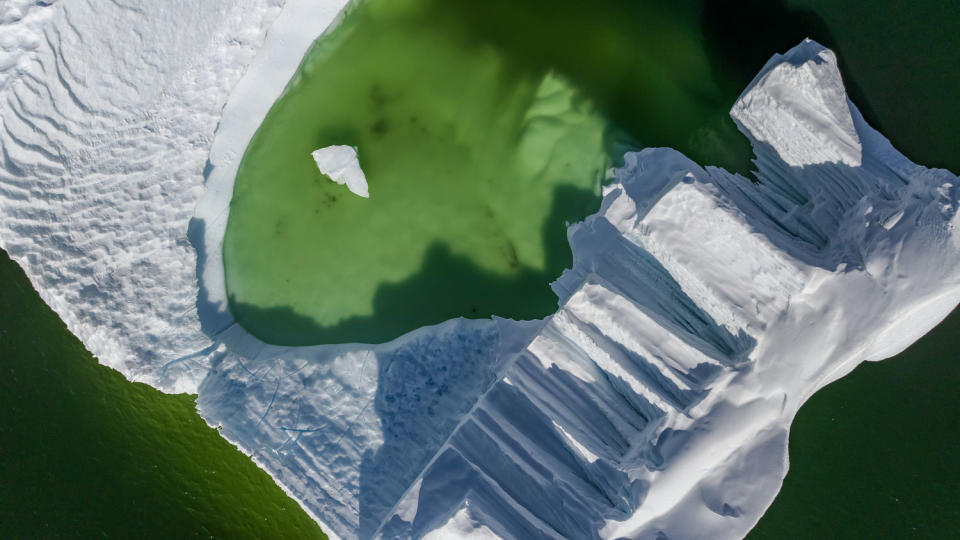Climate change is changing the Earth to its literary core, according to new research.
As polar and glacial ice melts due to global warming, water that was once concentrated at the top and bottom of the globe is being redistributed towards the equator. The extra mass around the center of the Earth slows its rotation, which affects our longer days.
A new study provides more evidence of that dynamic and also suggests that changes to the planet’s ice are deep enough to affect Earth’s axis – the invisible line at its center around which it rotates. Together, these shifts cause subsurface feedbacks, which affect the fluids that move around in the Earth’s molten core.
The results were published in two journals, Nature Geoscience and Proceedings of the National Academy of Sciences, in the past week.
The studies, along with similar research published in March, suggest that humans have tinkered with fundamental aspects of the planet’s physical properties – a process that will continue until sometime after global temperatures have stabilised. and the melting of the ice sheets to reach equilibrium.
“You can add the rotation of the Earth to this list of things that people have completely messed with,” said the author of the two new studies, Benedikt Soja, assistant professor of space geodesy at ETH Zurich in Switzerland.
The change in Earth’s spin is significant enough that it could one day rival the influence of the moon’s tidal forces, Soja said — if carbon emissions continue at extreme levels.
In general, the speed at which the Earth spins depends on the shape of the planet and where its mass is distributed – factors controlled by various reaction forces.
Scientists often offer a comparison to a figure skater spinning on ice: When skaters spin with their arms outstretched, their rotation will be slower. But if the skaters’ arms are kept tight, they turn faster.
Similarly, ocean tidal friction from the moon’s gravitational pull slows the Earth’s rotation. Historically, that has had the biggest impact on the planet’s spin rate, Soja said.
Meanwhile, the slow rebound of the Earth’s crust in some high-latitude regions after the removal of the Ice Age glaciers works in the opposite direction, accelerating the planet’s spin.
Both of these processes have long been predictable influences on the Earth’s angular velocity.
But now, the rapid melting of ice due to global warming is becoming a powerful new force. If humans continue to pollute the planet with carbon emissions, Soja said, the impact of ice loss could exceed that of the moon.
“In the worst cases, yes, climate change would be the most dominant factor,” he said.

A fourth important factor affecting the rotation of the Earth is the movement of the fluid within its core. Scientists have long understood that this can speed up or slow down the planet’s rotation – a trend that can shift over 10- to 20-year intervals. Right now, the core is temporarily causing the Earth’s spin to speed up a bit, counteracting the slowdown caused by climate change.
Climate change appears to be affecting the Earth’s core, too, as a result of melting ice and changes in the planet’s rotational axis.
The researchers behind the new study built a 120-year model of pole motion, or how the axis shifts over time. They found that changes in the mass distribution of the planet caused by melting ice probably contributed to small fluctuations in the polar motion.
Soja estimated that climate change was most likely responsible for 1 meter of change over 10 years.
The research also suggests that the movement of molten rock inside the Earth adjusts to the changes in its axis and rate of spin – a feedback process in which the Earth’s surface affects the interior.
“The rotation changes a little bit, and we believe that can indirectly affect the heart,” Soja said. “This is something that is not very easy or impossible to measure directly because we can’t go down there.”
The findings have implications for how people keep time and how we place satellites in space.
“If you want to fly a new mission to Mars, for example, we need to know exactly what the position of Earth is in space, and if that changes we could make a navigation error or a mistake,” a Soja said.
For example, a 1-meter shift in Earth’s axis could mean a spacecraft misses its target by 100 or 1,000 meters when it reaches Mars.
In terms of timekeeping, research published in March suggested that climate change has delayed the need to add a “second negative step” to Coordinated Universal Time to keep the world’s clocks in sync. the rotation of the Earth.
Duncan Agnew, a geophysicist at the Scripps Institution of Oceanography at the University of California, San Diego, who led that earlier study, said the new research “goes very well” with his work.
“It extends the result further into the future and looks at more than just a climate scenario,” Agnew said, adding that while Soja and her co-authors took a different approach, they achieved a similar result which he had
“Multiple discoveries are almost the rule in science – this is another case,” Agnew said.
Thomas Herring, professor of geophysics at the Massachusetts Institute of Technology, who was not involved in either study, said the new research could indeed shed light on how changes in the Earth’s surface can affect what is on walk within.
“As for the feedback between surface processes and the core, I think that’s plausible,” Herring said in an email, explaining that “large-scale” processes on the surface “can penetrate to the fluid core. “
This article was originally published on NBCNews.com